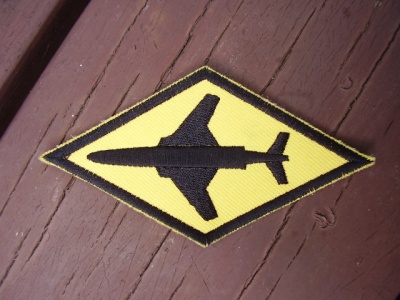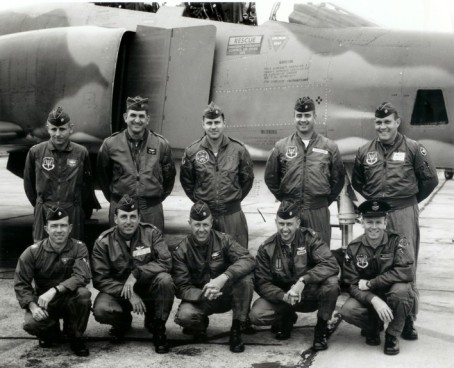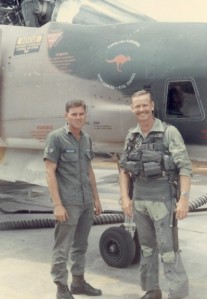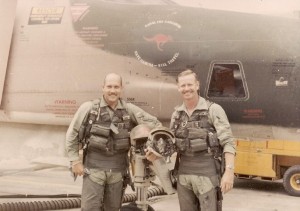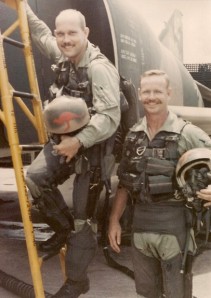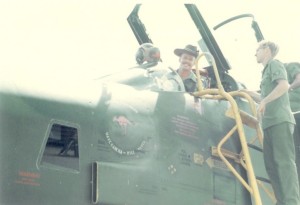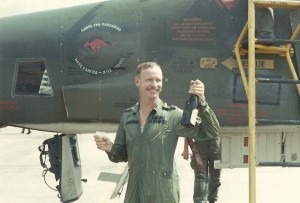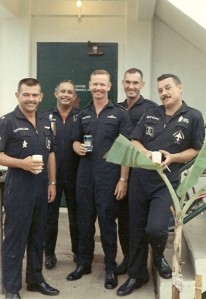DEC 2011 – This article will give enthusiasts a new insight to flightgear with a focus on a slightly unknown Aussie aspect – coverage of flightgear as used by RAAF aircrew in USAF RF-4C Phantoms, while conducting operations in South Vietnam in the 1960s.
RAAF UPGRADES TO MODERN EQUIPMENT IN 1960s
Back in the 1960s, the Royal Australian Air Force (RAAF) was slowly upgrading its aircraft platforms with new systems such as C-130E Hercules and Mirage IIIO. At the same time the RAAF was sending aircrew and members overseas to get new training/experience from trying new aircraft on exchange or “loan” tours.
As seen above the Mirage was a new RAAF aircraft in the 1960s. As part of this selection process that lead to the Mirage, the RAAF had evaluated the F-4C Phantom as a new aircraft but the Mirage IIIO won the competition instead due to better fitting the needsas a fighter.
F-4 PHANTOM – A VERSATILE AIRFRAME
The F-4 Phantom II was built with a 2 crew a pilot and radar/weapon system operator. It was a high speed aircraft, large size and could carry a wide range of missiles, bombs and rockets weapon systems. These features soon saw it become a multi service aircraft in the US armed forces line up.
After it finished its service trials by early 1960s, the F-4 Phantom was placed into service by the US Navy, US Marine Corps and eventually the US Air Force. It soon became a common sight across the world. The F-4 Phantom achieved many speed and height records in the 1960s showing off its amazing performance.
One of the roles the Phantom was modified to carry out was reconnaissance duties. This was done by modifying the nose and forward fuselage to hold special cameras and sensors such as SLAR. The first model went to the USMC as RF-4B Phantoms. These also saw use in Vietnam.
The USAF also saw a need for the reconnaissance Phantom and had a RF-4C model built to their requirements. The RF-4C was needed to replace the RF-101 Vodoo which had been doing the main USAF reconnaissance role since the mid 1950s. Below is a flight suit patch worn by F-101 crews and RF-101 crews to signify their aircraft mount to others. High visibility and the distinctive shape attracted attention and after the Vietnam War, much respect and recognition.
(More can be seen on the RF-101 and its Vietnam operations in my previous story – https://heritageflightgeardisplays.wordpress.com/?s=rf-101+vodoo ).
PILOT TRAINING EXCHANGE PLANS
To facilitate new aircraft skills and learn to fly while in a modern war zone, the RAAF sent a few select aircrew to US for conversion training onto the F-4 Phantom in exchange/pilot loan tours. From as early as 1965, some RAAF pilots/personnel were sent to USAF F-4C/D Phantom training units and others to RF-4C Phantom training units to learn to fly the F-4 Phantom. The RAAF exchanges would continue until 1971.
The RAAF chose to allocate over 6years to allocate 6 experienced pilots/aircrew members to fly in USAF F-4 Phantoms, as this would help gain new training skills and experiences to help the RAAF when the 24 loan USAF F-4E Phantoms would arrive in 1970 under Operation Peace Reef as a F-111C stop gap filler project…
VIETNAM WAR ESCALATES AND RECONNAISSANCE BECOME A PRIMARY MISSION
As the Vietnam war grew in size and requirement, the USAF decided to use the RF-4C alongside the RF-101 in filming targets on combat reconnaissance sorties / operations over South and North Vietnam… and Cambodia/Laos. The missions over South Vietnam were less intense and slightly safer than flying over North Vietnam, as the aircrews didnt face Surface to Air Missiles (SAM-2 Guidelines) or the North Vietnamese Air Force (NVAF).. but in South Vietnam all flying operations did experience at times, potential to come under varying intensity of VC/NVA ground fire…. and when not flying base attacks by VC sappers.
This more “safer” operational area of South Vietnam was where the Australian Government and RAAF saw it should get more operational aircrew experiences. The Government of the day, didnt want Australian aircrew going into North Vietnam airspace and creating a political problem if they were shot down / become POWs.
( Interestingly a RAAF pilot did end up flying over North Vietnam/Hanoi on exchange with the USAF…...)
RAAF ALLOCATES AIRCREW TO F-4 PHANTOM TRAINING
As the RAAF allocated its aircrew to the F-4 Phantom training squadrons in the USAF, the war in Vietnam was growing in intensity. The RAAF approved that the aircrew could deploy with their squadron to Vietnam to gain important front line operational experience for the aircrew back in Australia.
One of these units that was to gain an “Aussie on exchange/loan” was the 12th TRS / 460 TRW based at Tan Son Nhut Air Force Base in South Vietnam. Experienced RAAF pilot Sqn Ldr Alan Reed was chosen and sent to US for training in 1967.
RAAF SQNLDR Al Reed is shown while he was at Shaw AFB,South Carolina in 1967 during a RF-4C Instructor Conversion Course. The crews wear K-2B flight suits, L-2B flight jackets and garrison cap.
The RF-4C Phantom they flew was now becoming the primary reconnaissance aircraft for the USAF and was replacing the RF-101 in South and North Vietnam operations. The McDonnell Douglas RF-4C was chosen as a more adaptable and versatile reconnaissance platform in Vietnam as it could also fly at nighttime using its SLAR sensors.
12th TRS GOES TO VIETNAM – A WAR DEPLOYMENT
The 12 TRS squadron allocation to South Vietnam took Alan and his fellow squadron mates to Vietnam during 1968. The magic tour requirement was that every pilot had to fly 100 missions to get rotated out of SEA and back to the USA. This key number was constantly in everyone’s mind in the war. Some aircrew even came back for more tours. Some sadly died on their tours having survived their first.
KANGAROO SPOOK OVER SOUTH VIETNAM
Alan for most of his tour ….. was assigned to RF-4C Phantom – 67-0448. He did fly others in his tour. Phantom 0448 tho took on a special “Aussie” flavour and became quite popular. The aircraft nose area got painted with special noseart – a red coloured outline of a Australian Kangaroo surrounded with wording “Carolina Kangaroo / Have camera – Will Travel” Below we see in photos, the artwork as found on the airframe.
Senior Airman Doldo USAF (l) and SQNLDR Reed are seen on the ramp with “Carolina Kangaroo”. Alan wears a Australian made light green cotton RAAF flight suit, CSU-3/P g suit and PCU-15/P specially made for the use in F-4 Phantom by aircrews. He also wears a full stocked up SRU-21/P survival vest in case he is forced to bail out..
MAJ Jim Melton USAF Navigator (l) and SQNLDR Al Reed (r).Note the aircraft name “CAROLINA KANGAROO” “HAVE CAMERA – WILL TRAVEL” stencilled on their RF-4C. MAJ Melton hailed from North Carolina hence the aircraft name. The pilots wear K-2B flight suits for Melton and Reed in Aussie cotton RAAF flight suit. Both wear CSU-3/P g suit, and hold a HGU-2A/P dual visor ramshorn flight helmet with MBU-5/P oxygen mask. They were a full stocked up SRU-21/P survival vest in case they are forced to bail out..
MAJ Melton and SQNLDR Al Reed board the “Carolina Kangaroo” prior to another recon sortie over South Vietnam. The pilots wear K-2B flight suit for Melton and Reed wears a Australian made light green cotton RAAF flight suit. Both wear CSU-3/P g suit and hold a HGU-2A/P dual visor ramshorn flight helmet with MBU-5/P oxygen mask. The parachute harness they wear is a PCU-15/P specially made for the use in F-4 Phantom by aircrews. They wear a full stocked up SRU-21/P survival vest in case they are forced to bail out..
Note the special artwork with red roo on the visor cover.
In a very unusual display of artwork, the RF-4C also carried their artwork on the outboard external fuel drop tanks . MAJ Melton and SQNLDR Al Reed are seen sitting the starboard 370 US Gallon drop tank. The pilots wear K-2B flight suit for Melton and Reed wears a Australian made light green cotton RAAF flight suit. The parachute harness they wear is a PCU-15/P specially made for the use in F-4 Phantom by aircrews. They wear a full stocked up SRU-21/P survival vest in case they are forced to bail out..
END OF TOUR – MAGIC 100 MISSIONS
SQNLDR Reed celebrated flying 100 combat missions on November 5th 1968. After landing and taxiing in, he was entitled to a special party! A good old hose down and champagne was in order too.
SQNLDR Al Reed, RAAF in the cockpit of ‘his” RF-4C 67-0448 “Carolina Kangaroo” after his 100th mission, but prior to the traditional hose down after such an achievement. He wears a Aussie slouch hat.
SQNLDR Reed is congratulated on his 100 missions and is seen holding his champagne bottle and being thanked by a fellow squadron member. SQNLDR Reed celebrated his magic 100 combat missions mark on November 5th 1968. His light green cotton RAAF flight suit is noticeable in these photos by the snap buttons and RAAF rank slides on his shoulder.
SQNLDR Al Reed, RAAF gets the traditional hose down after completing 100 missions
SQUADRON PARTY FLIGHT SUITS
To let their hair down and relax, the aircrews were allowed to wear their “party suits” – special flights for partying. Some of these party suits are found on ebay for sale nowadays. Most come from USAF units that were based in Thailand.
SQNLDR Reed is seen with some USAF mates, wearing their black coloured “Party Suits”
………… AND WHATEVER HAPPENED TO CAROLINA KANGAROO AKA RF-4C PHANTOM 67-0448?
Old 67-0448 luck was with her and she survived the Vietnam War service.
She then spent time with the Bergstrom ANG “BA” 67 TRW / USAF ANG unit up until her retirement in the 1990s. The RF-4C Phantom was retired from service in 1992, ending up in Davis Monthan bone yard where she rests today. Information on her can be seen at the link – http://www.abpic.co.uk/photo/1015156/ and the photo below – thanks to Andrew Stevens –

This picture is © Andrew Stevens and may not be used or published without permission.
Based upon last known reports, the remains of the RF-4C 67-0448 still resides in storage at Davis Monthan AFB,Arizona.
UPDATE – JUNE 2012 – As of 2012 Carolina Kangaroo had been converted to a QRF-4C drone for a while ……..and was sadly shot down in a training mission in July 2012 Alan told me…… So no more Carolina Kangaroo…
(Credit – Many thanks to a long term fellow F-4 Phantom “Phanatic” – Mark for allowing me to share this rarely seen aspect of the RAAF operations during the Vietnam war. It is with special thanks to Alan Reed photos, courtesy of Mark Richardson RAAF F-4 webpage http://www.angelfire.com/extreme/raafphantoms/RAAFPHLYERS1.htm that this story can be told. Also to Andrew Stevens for RF-4C photo).

